This article offers a summary on medicinal plants for which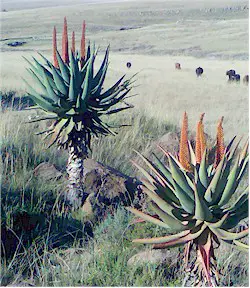 there are some reports on efficacy against veterinary parasites of livestock, dogs and cats such as fleas, ticks, mites, lice, flies, mosquitoes, roundworms, tapeworms, flukes, etc.
there are some reports on efficacy against veterinary parasites of livestock, dogs and cats such as fleas, ticks, mites, lice, flies, mosquitoes, roundworms, tapeworms, flukes, etc.
The literature on such plants is enormous. The vast majority of papers report on laboratory (so-called "in vitro") studies with plant extracts (in water, alcohol, hexane and several other organic solvents). Most of these papers conclude that more research should be done to evaluate the suitability of such plants for parasite control. In fact, there are very few examples of herbal products that have been thoroughly investigated under field conditions. To my knowledge there is no single commercial parasiticidal product for large-scale use on livestock based on plant extracts. There are a few such products for use on pets, but with a rather modest efficacy.
Many of these plants are so called "ethnobotanicals" used in traditional homemade remedies that have been used for centuries in various regions where these plants grow. Homemade remedies are prepared following poorly standardized recipes (traditional or self-developed) and usually result in more or less complex, undefined plant extracts that contain dozens if not hundreds of single chemicals naturally produced by the plants themselves, not all of them known, and not all of them with insecticidal or anthelmintic properties.
Some of the chemicals in plants extracts are well known and characterized (e.g. azadirachtin, citronellal, eugenol, D-limonene, geraniol, linalool, nicotine, pyrethrins, thymol, rotenone, etc.) and can be considered as "natural" active ingredients.
Some of these active ingredients have genuine insecticidal or anthelmintic properties (i.e. they actually kill some parasites), each one with its own spectrum of activity. They are also known as biopesticides. Others are more repellent than insecticidal. Such chemicals can be produced individually, either through industrial extraction out of plants that are grown and harvested for this purpose; or through synthesis in chemical factories in the same way as non-natural pesticides are manufactured.
Therefore it must be distinguished between four major types of "natural" veterinary parasiticides based on medicinal plants:
- Homemade remedies that you (or someone you know) produce at home in the kitchen (toilet, garage...). As previously explained, they are very complex mixtures of dozens of chemicals. In fact, you really don't know their exact composition. If they don't work, you will never know whether they do not work at all against a particular parasite, or whether you did something wrong. And whatever you do with them, it is under your own responsibility. There's nobody else to blame.
- Herb mixtures (dried, powdered, pelleted, etc.) commercially available for preparing infusions or for direct feeding to livestock or pets, with various claims against external or internal parasites. The claims are very seldom supported by serious efficacy trials. But it can be worth trying them.
- Industrially produced plant extracts (e.g. cedar oil, citronella oil, neem oil). Such oils are usually well characterized and standardized, and normally they can be considered as 100% of "natural" origin. However, the exact compositions of these oils are often not completely known and may be slightly different depending on the manufacturing process and on the plant origin. Not all components have parasiticidal efficacy. Commercial brands may contain more or less diluted pure oils or mixtures.
- Industrially produced single chemicals of "natural origin", either industrially extracted from plants, or artificially synthesized in chemical plants. They are mostly marketed as mixtures with a defined composition. But often the product labels do not indicate whether the ingredients are 100% natural (i.e. extracted from plants), or they have been "artificially synthesized". This category includes many of the numberless OTC "soft" products such as shampoos, soaps, lotions, sprays, powders, and the like, that offer some control of fleas, ticks, mites, lice, flies, mosquitoes, etc. Most of these natural veterinary products are approved for use on dogs, cats and other pets, but not for use on livestock. The reason is that it is a total different business to kill a few ticks or fleas on a dog, than to kill hundreds of ticks or flies on thousands of cattle.
You must be aware that all these categories, including industrially produced plant extracts as well as laboratory mixtures of "natural chemicals" are often submitted to a much looser approval process regarding quality (e.g. specifications), proof of efficacy, and safety than veterinary medicines. This means that they have not been thoroughly investigated according to the scientific methods required for veterinary parasiticides or pesticides, neither regarding their efficacy against a particular pest, nor regarding their safety for livestock, pets or humans. As a consequence, development of such products is quite easy and cheap, which is one of the reasons for their proliferation. Herb mixtures are usually not submitted to any veterinary registration process in most countries.
It seems that regulatory authorities in most countries actually follow the rule that if a product is natural, it is safe. And they don't care too much whether such a product really works or not: they delegate the responsibility to the market. If it works it will be successful. If not, it will be spontaneously withdrawn. It is true, that the vast majority of such commercial natural products are not seriously hazardous for animals, humans or the environment (they are usually biodegradable as well). However, regarding homemade remedies, "natural" does not mean "safe"! In fact, many plants can be poisonous to humans, livestock and pets, also those that have medicinal or insecticidal properties. Therefore the risk of harmful side effects of homemade remedies should not be underestimated! Be aware that various parts of each plant (leaves, stems, roots, fruits, seeds, bark, etc.) often have different compositions: some parts can be beneficial, whereas other parts can be toxic (mostly only if ingested).
A common feature of most of these natural products is that they are not persistent. They are easily degradable (e.g. by sunlight) and/or rather volatile, or quickly metabolized and excreted, which are rather positive features regarding safety. But the parasiticidal effect lasts often only a few hours or days. This means that treatment has to be repeated rather frequently if the animals need constant protection.
To learn more about natural insecticides click here.
To learn more about repellents click here.
Plants with insecticidal and/or anthelmintic properties
In the following a selection of plants is listed for which there are some reports on efficacy against external or internal parasites of veterinary importance. I strongly recommend you to run an exhaustive web search for additional information on each plant, before you try them.
Acacia auriculaeformis (Auri, Earleaf Acacia, Earpod Wattle, etc.) is a fast growing tree native to Indonesia and Australia. Contains saponins. Fruit extracts seem to be effective against some tapeworms. Anthelmintic properties have also been reported for other acacia species (e.g. Acacia oxyphylla, Acacia caesia).
Acorus calamus (Sweet Flag, Calamus, Beewort, etc.) is a perennial aquatic plant native to Southeast Asia, nowadays found vastly in the Northern Hemisphere and Australia. It contains tannins, asarone, eugenol, pinenes, etc. Powder from grinded rhizomes seems to have insecticidal activity against poultry lice and houseflies. It may be used for treating cowpats against fly larvae. It is suspected to be procarcinogenic when fed to animals over a long period of time. It is highly toxic to humans and animals, especially the berries.
Actaea spicata (Baneberry, Herb Christopher) is an herbaceous flowering plant native to mountain regions of Europe and Western Asia, found also in Siberia and North America. There are reports that lotions, ointments and powders made out of stems, flowers and leaves are affective against mange mites. It is highly toxic to humans and animals, especially the berries.
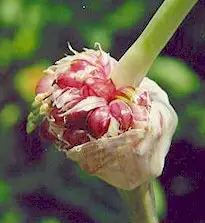
Allium sativum (Garlic). Onions and leaves contain alliin and allicin. In some regions it is used against lice. It is also recommended as a pet food capable of repelling ticks. It also shows efficacy against Ascarid roundworms and certain lungworms, but only as a preventative, because it does not prevent egg production by the worms in the intestine of the host, but only egg hatching in the host's feces. The anthelmintic effect seems to be due to its high sulfur content. It is used in some regions, mixed with other herbs. It can be mixed with food as fresh garlic or powdered. There are also garlic pills: 2 to 4 can be enough for lambs. For dairy animals it is recommended to administer it after milking, otherwise the milk will get garlic taste.
Aloe ferox (Bitter Aloe, Cape Aloe, Red Aloe, Tap Aloe, etc.) is a succulent native to South Africa that is also found in Southern Europe and America. Contains polyphenols, phytosterols, indoles, etc. The bitter juice is used for repelling flies and mosquitoes.
Amorpha fruticosa (Desert False Indigo, Bastard Indigobush, etc.) is a leguminous bush native to North America found also in Europe, Asia and elsewhere. It contains amorphol. The fruits can be grinded and extracted in acetone. After evaporation of the acetone the remains are diluted in water (1 liter for the extract of 100 g fruits). The resulting liquid can be applied to cattle grubs ensuring that it gets inside through the respiratory hole. Or the remains are diluted in petrol and used as fly repellent on cattle. It may keep horn flies and houseflies away for several hours.
Annona squamosa (Custard apple, Sugar apple, Sitaphal, Cherimoya, etc.) is a small tree native to tropical America now found worldwide in the tropics. Powdered seeds and immature fruits can be administered topically to animals against fly larvae (myiases), lice and other insects.
Artemisia absinthium (Absinthium, Wormwood, Green Ginger, etc.) is an herbaceous plant native to temperate Europe, Asia and Northern Africa. The whole plant contains eucalyptol and thujone (which is rather toxic). A water infusion seems to have an effect against fleas. Anthelmintic efficacy has been reported against gastrointestinal roundworms in sheep. Used in excess can be harmful because some animals don't tolerate it.
Artemisia vulgaris (Common Wormwood, Mugwort) is an herbaceous plant native to temperate Europe, Asia and Northern Africa. The whole plant contains thujone (which is rather toxic). Seems to be effective against some parasitic roundworms (e.g. Haemonchus, Bunostomum, and Protostrongylus). Sheep, goats and chicken take it easily.
Azadirachta indica (Neem, Nimm, Bevu, etc.) is a tree native to the Indian subcontinent. Nowadays it is found worldwide in tropical and sub-tropical regions. It contains azadirachtin, a vastly used biopesticide. Water and alcoholic extracts have shown promising efficacy against various ticks (e.g. Boophilus, Amblyomma, and Rhipicephalus) in field trials. In certain countries there are already commercial neem products for use on livestock. For domestic use, neem oil has a repellent effect against flies and other insects. It seems that it also works against mange mites. To get the oil, barked seeds are grinded to obtain a brown and sticky powder. This powder is mixed with water and the resulting paste is pressed to slowly obtain the oil. The leaves (preferably adult ones after fruiting) can also be left to soak in water for a few days. Efficacy of neem against parasitic worms is controversial: some reports confirm it; most studies do not.
Bursera copallifera (Copal) is a shrub native to America. Contains terpenoids, flavonoids and lignans. Acetonic stem extracts showed efficacy against Haemonchus contortus in laboratory studies.
Butea monosperma (Bastard Teak, Parrot Tree, Palash, Dhak, Palah, etc.) is a flowering tree native to India and Southeast Asia. Contains palasonine. There are reports on laboratory efficacy of leaves and seed extracts against some roundworms, tapeworms and flukes. Powdered seeds fed to sheep showed some efficacy against mixed infections with gastrointestinal roundworms.
Caesalpinia crista (Fever Nut, Bakaig, etc.) is a deciduous tree that grows in Asia and Latin America in tropical and subtropical regions. Alcoholic seed extracts showed efficacy against Haemonchus contortus larvae in laboratory studies. In vivo trials on sheep showed some efficacy against mixed infections with gastrointestinal roundworms.
Calotropis procera (Sodom apple, Mudar, Stabragh, etc.) is a flowering shrub native to Africa and Asia. Contains aglycans that are heart poisons. Latex fed to sheep showed some efficacy against Haemonchus contortus infections.
Cannabis sativa (Marijuana, Hemp, etc). Crude leave extracts showed some some efficacy against certain flukes in laboratory tests.
Capparis decidua (Kair, Karir, Kerda, Kirir, etc.) is a shrub native to Asia. Extracts from root bark contain spermidine alkaloids and have shown some anthelmintic efficacy in laboratory tests.
Carica papaya (Papaya, Papaw) is a fruit tree native to tropical America. Contains benzyl isothiocyanate. Latex and seed extracts fed to chicken showed some efficacy against parasitic roundworms (Heterakis gallinarum, Ascaridia galli, etc.). The latex was used against various roundworms in the early 20th century.
Centratherum (=Vernonia) anthelminticum (Black Cumin) is a flowering plant native to Asia vastly used in traditional Ayurvedic medicine. Seed extracts showed efficacy against some ascarid roundworms (e.g. Toxocara vitulorum) and threadworms (e.g. Strongyloides).
Chenopodium album (Goosefoot, Lamb's Quarters, Melde, Goosefoot) is an annual weed native to Europe but nowadays cultivated worldwide. In vivo trials on sheep showed some efficacy against mixed infections with gastrointestinal roundworms. The oil can be deadly toxic if ingested
Chrysanthemum cinerariaefolium (Daisies, Mums, Chrysants, Xants) is a perennial flowering plant native to Asia and Southeast Europe, nowadays cultivated worldwide. They are vastly used as ornamentals and for the production of natural pyrethrins, the most widely used natural insecticides.
Citrus maxima (Pomelo) and Citrus reticulata (Mandarine) are citrus trees native to Asia nowadays grown worldwide in regions with tropical or moderate climate. The peel is very rich in D-limonene. In laboratory studies peel extracts showed promising efficacy against adult Boophilus ticks. D-limonene is widely used as insect repellent in numerous OTC pet products.
Cleome icosandra (= viscosa). (Asian Spider Flower, Hul-Hul) is an annual weed found in tropical regions of the world. Aqueous and alcoholic extracts of the seeds showed some efficacy against Ascaridia galli in laboratory studies.
Commiphora mukul (Guggul) is a small flowering tree found in North Africa and Central Asia. The resin extract has shown some anthelmintic efficacy against roundworms (ascarids) and tapeworms.
Cucurbita maxima; Cucurbita moschata (Squash, Pumpkin). Contains cucurbitacins. Aqueous or alcoholic seed extracts have shown some efficacy against Haemonchus contortus in laboratory studies. It is also used in traditional medicine to expel tapeworms. The seeds can be directly fed to livestock.
Cymbopogon nardus and Cymbopogon winterianus (Barbed Wire Grass, Citronella Grass, Lemon Grass, etc.) are perennial grasses native to Asia, nowadays found worldwide in regions with tropical and temperate climate. The oil contains citronellal, geraniol, D-limonene, camphene, etc. The oil or single chemicals are widely used as insect repellents in numerous OTC products (shampoos, sprays, lotions, dusts, etc.) for pets.
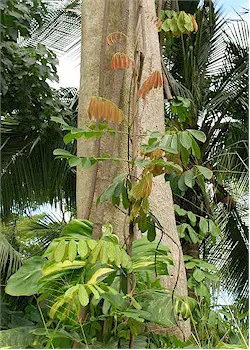
Derris elliptica (Tuba, Hon, etc.) is a climbing liana native to Southeast Asia nowadays found in most tropical regions. It contains large amounts of rotenone, a potent natural insecticide. Vastly used in many commercial pesticides and parasiticides. Grinded roots mixed with water and soap (1 kg roots, 10 liters water, 250 g soap: filter the broth after 24 hours soaking) produce a extract that can be applied topically to animals against ticks, lice, mites and cattle grubs. Root powder mixed with talcum powder can also be used for dusting animals (avoid dusting the eyes!). Very toxic to fish, less toxic to mammals.
Dryopteris filix-mas (Male Fern) is a common fern native to the Northern Hemisphere. Contains phloroglucinol derivatives. The roots and the young leaves have been used until recently in human medicine to expel tapeworms.
Dysphanya (=Chenopodium =Teloxys) ambrosioides = Chenopodium anthelminticum (Epazote, Paico, Wormseed, Mexican tea, etc.) is a flowering herb native to Central and South America. Efficacy against gastrointestinal roundworms has been shown on lambs. In some countries it is directly fed to pigs. Grinded seeds are still used as human anthelmintic in some countries. The essential oil contains ascaridole, D-limonene and p-cymene. The oil (Baltimore Oil), which is quite toxic to humans and animals, was vastly used in the early 20th century as anthelmintic against ascarids and hookworms for humans, pets and livestock. It was replaced later by more effective and less toxic medicines.
Eucalyptus globulus (Blue Gum, Tasmanian Blue Gum, etc.) is an evergreen tree native to Australia, nowadays vastly cultivated for industrial purposes in many parts of the world. Eucalyptus oil contains eucalyptol (=cineole), a vastly used biopesticide. Emulsifiable concentrates of the essential oil showed high efficacy against housefly larvae and pupae.
Evolvulus alsinoides (Dwarf Morning-glory) is a perennial weed growing in tropical and subtropical regions of the world. Ethanolic extracts of the whole plant showed some anthelmintic efficacy in laboratory studies.
Ficus insipida (=glabrata) (Ojé) is a tree native to tropical South America. The latex contains ficin. The latex has shown anthelmintic activity and has been used in traditional medicine in the Amazon region. It is quite toxic to humans and must be considered unsafe for livestock and pets.
Gynandropsis (=Cleome) gynandra (Spider Flower, Apoi-Apoian, etc.) is an annual herbaceous plant. The seeds seem to have insecticidal properties against myiases, lice and mites. Alcoholic extracts of stems and leaves showed some efficacy against flukes (Fasciola hepatica) and tapeworms (Taenia solium).
Gymnocladus dioica (Kentucky coffeetree) is a tree native to the Midwest of North America. It is said that grinded leaves mixed with sugar and water attract and kill flies. Unroasted pods and seeds are toxic.
Hagenia abyssinica (African Redwood, Brayera, Hagenia, Kosso, etc) is a flowering tree native to central and eastern Africa. The infusion of powdered flowers was used against tapeworms in humans and pigs until the early 20th century.
Juglans nigra (Eastern Black Walnut) is a large tree native to Eastern USA, nowadays also cultivated in Europe and elsewhere. Contains juglone, which can be toxic to other plants and some animals. The water extract (soak leaves for a few hours in water and then boil them) applied topically to animals is said to repel flies. Grinded leaves scattered on the ground are said to keep ticks, lice, and mites off stables, kennels, piggeries, poultry houses, etc.
Juniperus communis (Juniper, Aiten, Hackmatack, Gorst, etc.) is an evergreen shrub common in the cool temperate Northern Hemisphere. Contains pinene, sabinene and juniperene. The oil showed anthelmintic activity against roundworms (Ascaridia galli) in laboratory studies. The berries seem to have some in vivo activity against flukes (Fasciola hepatica). Sheep will feed the berries spontaneously.
Lupinus angustifolius, Lupinus albus, Lupinus ballianus (Lupin, Lupine) is a flowering plant occurring worldwide in temperate climates. Contains alkaloids (e.g. lupinine, sparteine) Can be toxic to humans and livestock. Seed extracts are said to have anthelmintic properties.
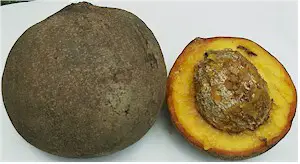 Mammea americana (Mamey, Mammee, Mammee Apple, etc.) is a perennial tree native to tropical America, now cultivated in tropical Africa and Asia as well. Shavings or slices of half ripe fruits soaked in water allow pressing a greenish gummy fluid which seems to kill fleas, ticks, and lice. Seed powder topically applied to animals is said to have the same effect.
Mammea americana (Mamey, Mammee, Mammee Apple, etc.) is a perennial tree native to tropical America, now cultivated in tropical Africa and Asia as well. Shavings or slices of half ripe fruits soaked in water allow pressing a greenish gummy fluid which seems to kill fleas, ticks, and lice. Seed powder topically applied to animals is said to have the same effect.
Manihot esculenta (Cassava, Manioc, Yuca, etc) is a perennial shrub common in tropical and subtropical regions vastly used as animals and human food. Leaves feed to calves showed some efficacy against Haemonchus contortus roundworms.
Melia azedarach (Chinaberry Tree, Bead-tree, etc) is a deciduous tree native to Southeast Asia and North Australia. Leaves have been used as natural insecticide to protect stored food from insects. A spoon of dried grinded seeds mixed with laundry soap in water (about 1 gallon) seems to repel fleas and other insects when sprinkled over lawns, shrubs, etc. Ethanolic extracts of the fruits showed some efficacy against tapeworms (Taenia solium) in laboratory studies. The fruits are toxic to humans.
Melaleuca alternifolia (narrow-leaved Paperbark, narrow-leaved Tea-tree), a shrub native to Australia. Dipping and jetting with 1% and 2% oil formulations controlled sheep lice (Bovicola ovis) on sheep in pen studies.
Mentha piperita (Peppermint) is a perennial herbaceous plant (an hybrid of other Mentha species), native to Europe now found worldwide. Peppermint oil contains various biopesticides, such as caryophyllenes, D-limonene, menthone, menthol, pinenes, pulegone, etc. Emulsifiable concentrates of the essential oil showed high efficacy against houseflies in field studies.
Mentha pulegium (Pennyroyal, Mosquito Plant, Pudding Grass, Squaw Mint, etc.) is a perennial grass native to Europe now widespread in the whole world. Grinded dried leaves seem to work against fleas and ticks on domestic animals. The powder can be used for dusting the animals' hair coat or the resting places of pets or birds. The water extract can also be used for bathing pets. The essential oil was effective against red poultry mites (Dermanyssus gallinae) in laboratory trials. However, the essential oil should never be used on humans or pets because it is very toxic, even at very low levels.
Mimusops elengi (Bullet wood, Spanish Cherry, Medlar, etc) is an evergreen tree native to tropical Asia. Contains taraxerol and taraxerone. Bark, flowers and fruits are used in ayurvedic medicine as anthelmintic. Alcoholic extracts showed some efficacy against roundworms (Ascaridia galli) in laboratory studies.
Moghania (=Flemingia) vestita is a leguminous root crop native to Asia. Contains genistein. Extracts from root-tuber peel showed some efficacy against flukes (Paramphistomum spp) and tapeworms (Raillietina echinobothrida) in laboratory studies.
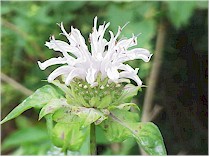 Monarda fistulosa (Wild Bergamotte, Bee Balm) is a perennial flowering plant native to North America. Contains thymol, carvacrol, p-yamene. Used by Native Americans in traditional medicine. It is said to have anthelmintic properties against hookworms.
Monarda fistulosa (Wild Bergamotte, Bee Balm) is a perennial flowering plant native to North America. Contains thymol, carvacrol, p-yamene. Used by Native Americans in traditional medicine. It is said to have anthelmintic properties against hookworms.
Moringa oleifora (Moringa, drumstick tree, horseradish tree, Malungay) is a small tree native to India. Flowers, leaves and fruits are used as food. Aqueous and alcoholic extracts showed efficacy against certain worms in laboratory studies.
Nicotiana tabacum (Tobacco) is a perennial herb (probably an hybrid of other species) native to America but nowadays cultivated worldwide. It is well known that tobacco plants contain nicotine, which is also a potent insecticide. Before the introduction of modern synthetic pesticides tobacco leaf extracts were vastly used as an agricultural pesticide. A water extract of leaves or any parts of the plant can be used for spraying livestock and pets against various external parasites. The juice of leaves seems to work as an insect repellent when rubbed on the body. Aqueous and alcoholic extracts showed in vivo efficacy against gastrointestinal roundworms (Haemonchus contortus) on sheep. But the effective dose is very close to the toxic dose for livestock.
Nigella sativa (Fennel flower, Kala Jiri, Roman Coriander, Black Cumin, etc) is a flowering plant native to Southwest Asia. Seed extracts showed some anthelmintic efficacy against tapeworms and some roundworms (e.g. Oesophagostomum spp) in studies in vitro and in vivo on sheep.
Neolamarckia cadamba (Kadam) is an evergreen tree native to Southeast Asia. Extracts of the bark showed some anthelmintic activity against certain parasitic roundworms and tapeworms in laboratory studies.
Ocimum sanctum (Basil Herb, Holy Basil, Sacred Basil, Tulsi) is an aromatic herb used in Indian traditional medicine. Contains eugenol. The essential oil showed efficacy against certain worms in laboratory studies.
Origanum minutiflorum (Wild Origanum) is a perennial herb native to the Mediterranean and Eastern Asia, nowadays cultivated worldwide. The essential oil contains thymol and carvacrol, both chemicals with insecticidal properties. In laboratory studies it showed some efficacy against ticks.
Phytolacca icosandra (tropical pokeweed). Ethanolic extracts from leaves showed some anthelmintic effect against Haemonchus contortus in feeding studies on goats.
Piliostigma thonningii (Camel's Foot, Mchekeche, Monkey Bread, Rhodesian Bauhinia, wild bauhinia) is a medium-sized deciduous tree native to sub-humid Africa. Bark extracts contain methylchiroinositol and showed some efficacy against larvae of Haemonchus spp in laboratory studies.
Pimenta dioica (Jamaica Pepper, Myrtle Pepper, Newspice, Pimienta, etc.) is a perennial tree native to Central America and the Caribbean now grown in many tropical and subtropical regions. The fruits contain eugenol and caryophyllene, both with insecticidal activity against fleas, flies and mites.
Piper longum (Indian Long Pepper, Pippali, Kana, Magadhi) is a flowering vine native to Asia and cultivated for its fruits that are used a spice. Crude powder and aqueous extracts administered orally to goats showed some efficacy against gastrointestinal roundworms. In laboratory studies, the alcoholic fruit extract showed activity against Toxocara cati and the essential oil showed efficacy against Ascaris lumbricoides, a human parasite.
Prosopis laevigata (Smooth Mesquite) is a flowering tree native to the Americas. Hexanic extracts from stems and leaves showed some efficacy against Haemonchus contortus in laboratory studies.
Polygonum (= Persicaria) hydropiper (Water-pepper, Marsh Pepper, etc.) is an annual plant of the Northern hemisphere that grows in marshes and shallow waters. Among other constituents the essential oil contains eucalyptol and caryophyllene that have insecticidal properties. The juice is used in some places to keep flies off livestock injuries.
Punica granatum (Pomegranate) is a tree native to Iran vastly cultivated for its fruits. Alcoholic bark extracts showed some efficacy against Haemonchus contortus larvae in laboratory studies. Grinded dried rind of immature fruits fed to buffaloes showed some efficacy against infections with Schistosoma spp.
Ricinus communis (Castor Bean Plant) is a flowering perennial plant native to East and Northeast Africa now found worldwide in tropical regions. Dried and grinded leaves and stems are used as a dust for direct topical application on sheep, goats, poultry and pets against fleas, flies and mites. The seeds contain ricin, which is highly toxic to humans and animals.
Rosmarinus officinalis (Rosemary) is a perennial herb native to the Mediterranean now cultivated worldwide. The essential oil contains several chemicals with insecticidal properties, e.g. camphor, eucalyptol and pinenes. Grinded leaves are said to repel fleas and ticks.
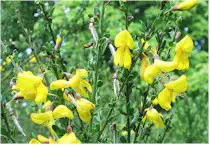 Sarothamnus scoparius = Cytisus scoparius (Common Broom, Scotch Broom) is a perennial leguminous shrub native to Europe. Contains tannins, flavonoids (genistoside) and alkaloids (sparteine and lupanine). Extracts showed some efficacy against gastrointestinal roundworms of sheep (Teladorsagia circumcincta, Haemonchus contortus, Trichostrongylus colubriformis) in laboratory studies.
Sarothamnus scoparius = Cytisus scoparius (Common Broom, Scotch Broom) is a perennial leguminous shrub native to Europe. Contains tannins, flavonoids (genistoside) and alkaloids (sparteine and lupanine). Extracts showed some efficacy against gastrointestinal roundworms of sheep (Teladorsagia circumcincta, Haemonchus contortus, Trichostrongylus colubriformis) in laboratory studies.
Schoenocaulon officinale (Sabadilla, Cebadilla) is a tropical lily native to Central America and the Caribbean. Contains various alkaloids such as cevadine and veratridine. It was vastly used as a pesticide in the past, before the introduction of modern synthetic insecticides. Nowadays there are still numerous cebadilla-derived products used as biopesticides in agriculture. Grinded seeds heated up to 150° during one hour seem to be effective against lice.
Semecarpus anacardium (Bhilawa, Marking Nut, Oriental Cashew, Malacca Bean) is a deciduous tree native to India. Contains anacardic acid. Various extracts from the oil showed some anthelmintic efficacy against certain worms. It is toxic to humans and other mammals.
Sericea lespedeza (Chinese Bushclover) is a perennial herb, native to temperate Asia introduced in America and elsewhere. Used as fodder and ornamental. Studies have shown that goats grazing on Sericia lespedeza or fed its hay mixed with other grasses showed lower burdens of gastrointestinal roundworms such as Haemonchus contortus.
Strobilanthes discolor is a flowering plant native to tropical Asia. The leaves are used as a wormer in traditional medicine in India. In laboratory studies the leave extracts showed some anthelmintic efficacy against certain tapeworms.
Stylosanthes scabra (Pencilflower, Seca, Seca Stylo, etc.) is a perennial forage legume native to South America. It has a repellent and killing effect on certain tick species. It contains proveratrines. Methanol extracts showed lethal effects on ticks in laboratory studies.
Syzygium aromaticum (Clove) is a medium-sized tree native to tropical and subtropical Asia. The dried flower buds are highly appreciated as a spice worldwide. Contains eugenol. Used in traditional medicine in many countries in Asia, also as an anthelmintic.
Tabernaemontana citrifolia (Common Milkwood, Milky bush) is a flowering plant native to the Caribbean. It is used traditionally as an anthelmintic for humans and livestock in several Caribbean Islands. Extracts of leaves, fruits and roots showed efficacy against gastrointestinal roundworms (Haemonchus contortus) in laboratory studies.
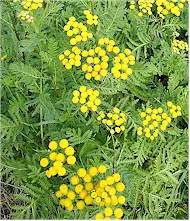 Tanacetum vulgare (Tansy, Bitter-buttons, Parsley Fern) is a flowering plant native to the Northern Hemisphere. The oil contains tannins and thujone. Was used in the past as traditional anthelmintic and against human fleas and lice. However, if ingested, a few grams are already toxic to humans and animals. Feed to sheep it showed some efficacy against certain gastrointestinal roundworms (Nematodirus spp).
Tanacetum vulgare (Tansy, Bitter-buttons, Parsley Fern) is a flowering plant native to the Northern Hemisphere. The oil contains tannins and thujone. Was used in the past as traditional anthelmintic and against human fleas and lice. However, if ingested, a few grams are already toxic to humans and animals. Feed to sheep it showed some efficacy against certain gastrointestinal roundworms (Nematodirus spp).
Thymus vulgaris (Thyme) is an herbaceous plant native to the Mediterranean. The essential oil contains thymol, carvacrol, linalool, and caryophyllene, which have insecticidal properties. Laboratory studies showed efficacy of the essential oil against the red fowl mite, Dermanyssus gallinae and mosquito larvae. Thyme seems to have anthelmintic properties as well.
Trachyspermum ammi (Ajowan, Ajwain, Bishop's Weed, Carom Seeds) is a flowering plant native to Egypt and widespread in Asia. Contains, tannins, thymol, cymenes, pinenes). The seeds are used as a spice in many Asian countries. Seed extracts showed ovicidal effect on gastrointestinal roundworms (Haemonchus contortus) in laboratory studies. The essential oil is toxic if ingested.
Trifolium repens (White Clover, Dutch Clover) is an herbaceous perennial plant native to several regions of the Northern Hemisphere. It is an excellent forage crop for grazing livestock. Plant extracts showed some efficacy against certain tapeworms in laboratory studies. In controlled studies lambs grazing on monocultures of white clover showed lower infection rates with stomach roundworms than lambs grazing on ryegrass or alfalfa.
Veratrum album (white Veratrum, white Hellebore, false Helleborine, etc.) is a perennial lily herb native to Europe. It contains cevadine and veratridine. Powdered roots seem to kill fly larvae in manure. Extracts obtained after decoction of the rhizome are said to be effective against mites, lice and cutaneous myiases when applied topically to livestock. It is toxic to humans and animals.
Xylopia aethiopica (African Pepper, Guinea Pepper, Ethiopian Pepper, Spice Tree) is an evergreen tree of the African savanna. The fruits are used as a spice an in traditional medicine, also as a wormer for livestock. Alcoholic seed extracts showed some anthelmintic efficacy against roundworms (hookworms) in laboratory studies.